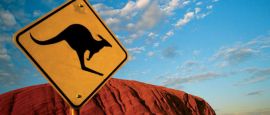Also known as Katherine Gorge, this spectacular canyon system lies in the Northern Territory and rewards those who make the trip with one of the most memorable canoeing adventures in the country. The gorge is sacred to local indigenous groups. Choose from a few hours’ hire to a multi-day trip.
Australia things to see and do
Australia’s east coast is brimming with mainstream tourist hotspots, from the brash hedonism of Surfer’s Paradise to the 4-wheel-drive-friendly Fraser Island, but for most leisure visitors it’s the Great Barrier Reef that remains the must-see sight. It’s vast (2,300km/1,430 miles long, to be precise) and is arguably best experienced through diving and sailing trips to the Whitsunday Islands.
If you’re looking for outback adventure, there are few better options than this 600km (370-mile) road across the Kimberley. Venerated by enthusiasts for both its rugged scenery and its challenging conditions, it can only be negotiated by 4-wheel drive vehicle. There’s a shorter ‘tourist loop’ at the western end of the road.
Some cities just get it right. And Melbourne is one of them, giving visitors everything from Victorian-era architecture to cutting-edge counterculture, while also placing plenty of importance on food, festivals, the great outdoors and sport. A month or so here, among the laneway bars and street markets, and you’ll be praising the city for life.
Australia knows all about otherworldly landscapes, but the orange-striped beehive domes of the Bungle Bungle Range – high up in Western Australia in Purnululu National Park – is one of the most extraordinary examples in the country. Take a scenic flight to get a sense of the scale of the domes.
Generally to be found near the top of the list of those “world’s most liveable cities” surveys, South Australia’s capital is rightly seen as something of an urban gem. Attractive and uncrowded, it’s renowned for its parks, its art galleries and its busy cultural calendar, which includes the largest arts festival in the southern hemisphere, the Adelaide Fringe.
Tasmanians cheekily refer to mainland Australia as ‘the north island’, and you can forgive the self-confidence. The island state is deserving of as much time as you can spare, cramming in an extraordinary variety of landscapes and outdoor activities. In Hobart, meanwhile, it also boasts a highly liveable capital city.
Western Australia’s biggest city is something of a slow-burner. It lacks the immediate wham-bam of Sydney and Melbourne, but for those who take the time to explore its parkland, beaches and laidback urban vibe, it’s somewhere that’s easy to love. The surrounding region, offering up winelands and character-rich towns, adds to the appeal.
‘Litchfield-do, Kaka-don’t’. So runs the tongue-in-cheek advice from the Northern Territory’s locals when it comes to choosing between their main national parks. Litchfield lacks the epic majesty of Kakadu, but its cascading waterfalls and swimming holes make it a deservedly more popular day-trip from Darwin.
The Blue Mountains’ proximity to Sydney makes them a near-essential part of any New South Wales itinerary. Their name comes from the bluish haze given off by the eucalyptus trees that carpet the range’s huge slopes. A great spot for everything from bush-walking to horse-riding.
Many visitors never make it down to South Australia, which makes the rolling mountains of the Flinders Ranges all the more special. They play home to national parks, sleepy towns and the kind of true-blue Aussie character that the country’s famous for – don’t miss the colossal natural amphitheatre of Wilpena Pound.
Wrapped up in endless layers of spiritual significance, Kakadu National Park offers 20,000 sq km (7,700 sq miles) of untamed (and some would say unrivalled) Australian wilderness. There are crocs, creeks, escarpments and waterfalls, as well as an immense collection of ancient Aboriginal rock art.
A north-south alternative to the east-west passage of the Indian Pacific, The Ghan passenger train chugs the full length of the country from Darwin to Adelaide, calling in at Alice Springs and Katherine en route. It’s a great way of taking in the breadth of the outback while enjoying Aussie wine, good food and comfortable cabins.
Where to start with Sydney? It’s a toss-up as to whether the locals or the tourists do the most swooning over it, and once you’ve experienced the surf beaches, the harbour, the skyline and that warm, lazy-day culture, it’s not hard to understand why. Give the place as much time as possible.
Showcasing arguably the finest surf-pounded coastal scenery in the country, the Great Ocean Road sits within driving distance of Melbourne. It’s 250km (155 miles) long, so can be ‘done’ in a couple of days – far better, though, to take your foot off the gas and experience its towns and beaches at a relaxed pace.
Every bit as magical as the hype would suggest, ‘The Rock’ is the kind of monumental natural feature for which sightseeing seems too crude a category. Getting there can be time-consuming, but the reward (like Uluru itself) is immense. Take time too to visit nearby Kata Tjuta, in many ways just as epic a landmark.
Do you have any Feedback about this page?
© 2025 Columbus Travel Media Ltd. All rights reserved. No part of this site may be reproduced without our written permission, click here for information on Columbus Content Solutions.









 You know where
You know where